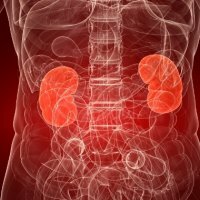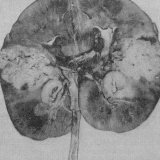Symptoms of kidney failure

Renal failure is a serious pathology, due to which the kidneys completely or partially stop performing their function. They do not maintain a constant chemical composition inside the body, a number of metabolic disorders occur.
There are two types of renal failure:
- acute - occurs as a one-time, sharp attack;
- chronic - a constant pathology developing for a long time.
Acute renal failure - occurs in different circumstances. It can be exposure to toxic substances, insufficiency can also appear as a result of trauma, infectious insufficiency often occurs, they all lead to shock. To present an understandable picture, as a result of such effects, normal blood circulation in the kidneys stops, anoxia then arises, the kidney becomes atrophied and tissues begin to die in the renal tubules. In case the insufficiency is caused by toxic substances, the epithelial death time in the tubules is significantly reduced, since nephrotoxic substances accelerate the process.
Acute insufficiency
Acute deficiency develops rapidly, with pronounced intoxication and vomiting, while CNS is affected, coma or cardiac arrest may occur. There are four stages:
- At the first stage, facts of poisoning and shock state of the organism are visible, it takes 1-2 days. In this case, there are symptoms of jaundice or unhealthy pallor, a strong chill, a temperature jump, a decrease in pressure. The analysis of urine in 90% of cases contains a blood pigment, leukocytes, erythrocytes, protein.
- The second stage - the kidneys due to their disrupted work, can process no more than 300 ml of urine per day. This condition can last for 1-2 weeks. In connection with the fact that the kidneys do not work, many minerals, nitrogenous products are formed and enter the blood, uremia develops. The patient is tormented by constant vomiting, lack of appetite, apathy and weakness, headaches due to severe insomnia, blood tests show the presence of anemia. In patients in the second stage, mental illnesses, epilepsy, delirium, etc. often develop.
- In the third stage urine output significantly improves per day, but in the general picture this does not affect in any way, on the contrary, the condition worsens. This stage lasts about 2 weeks, the kidney function is significantly deteriorating, there comes a time when the concentration ability drops and the failure is clearly revealed. The content of nitrogen products can reach a critical point. Such a polyuric stage selects the maximum amount of the patient's strength, it loses weight, dryness of mucous membranes and skin, weakness and a constant thirst feel.
- At the fourth stage, there comes a period of apparent calm, when urine tests do not detect nitrogen, protein and other elements, it can take several months. It is worth noting that in acute failure may develop a complication in the form of necrosis of kidney tissue. Nevertheless, it is treated, and the kidneys are almost completely restored.
Chronic failure
Chronic renal failure is as a result of several kidney diseases, this includes:
- chronic bilateral pyelonephritis;
- chronic diffuse glomerulonephritis;Polycystic kidney disease and a number of other diseases.
Sometimes chronic failure is observed in the case of unilateral kidney diseases, but in the end, arterial hypertension is obtained, and the second kidney wrinkles.
Chronic failure is also characterized by 4 stages:
- A latent or latent stage, it can be found only when examining the kidneys, the patients themselves do not bother, barely noticeable fatigue and dryness of the oral mucosa;
- The second stage - compensated, marked by a sharp manifestation of polyuria, the excretion of urine can exceed 2.5 liters per day. There are the same signs as in the first stage, but are slightly more pronounced;
- The third, intermittent stage, this period is characterized by a large release of nitrogen, increased dryness of the skin and mucous membrane, loss of appetite and manifested yellowness on the skin. At this stage, immunity is sharply reduced, as a result of which a person is susceptible to infectious diseases, and their flow is much more complicated. There are temporary improvements and again worsening;
- The fourth stage is terminal, it is extremely dangerous, because the processes occurring in the body are irreversible. At the same time, acidosis intensifies, general dystrophy occurs, metabolic disturbances increase. As a result of the accumulation of toxins, blood anemia appears, cardiac rhythm and cardiovascular system disorders increase, eventually there may be cardiac ischemia.



